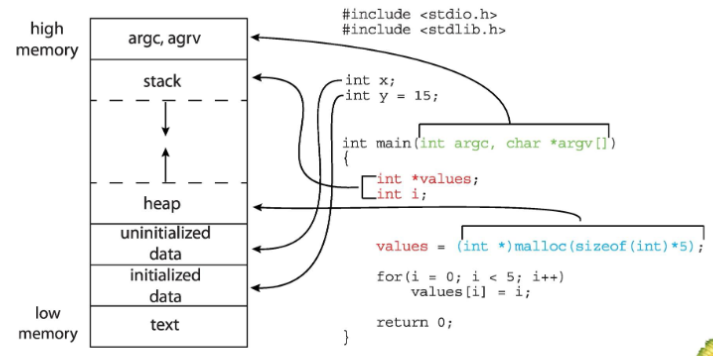COMP 3511: Lecture 5
Date: 2024-09-17 14:56:54
Reviewed:
Topic / Chapter:
summary
❓Questions
Notes
Operating System Design and Implementation
-
Design and implementation of OS
- not solvable / no optimal solution
- characteristics
- internal structure: varies widely
- even at high level: design affected by choice of hardware / system type, etc.
- desktop / laptop / mobile / distributed / real- tie
- design: starts with specifying goals & specifications
- user goals: OS being convenient to use
- and ease to learn & use
- reliable, safe, fast
- system goals: easy to design, implement, and maintain
- and flexible, reliable (hopefully) error-free & efficient
- user goals: OS being convenient to use
- highly creative task of SWE
-
Important principle ⭐
- separation of policy & mechanism
- policy: what will be done
- mechanism: how to do it?
- e.g. time construct, mechanism for ensuring CPU protection
- deciding how long the timer will be: policy decision
- e.g. time construct, mechanism for ensuring CPU protection
- 👨🏫 policy: often changes
- separation of policy from mechanism: allows flexibility even policies change
- w/ proper separation: mechanism can be used to policy decision for
- prioritizing IO-intensive program
- as well as vice versa
- w/ proper separation: mechanism can be used to policy decision for
- OS: designed w/ specific goals in mind
- which: determine OS policies
- OS: implements policies through specific mechanisms
- separation of policy & mechanism
-
Implementation
- early OSes: written in assembly (~= 50 yrs a go)
- modern OS: written in higher level language
- for some special device/ function: assembly might still be used
- but general system: written in C/C++
- frameworks: in Java, mostly
- w/ higher level language: it can be easily ported
- also, code can be write faster, compact, and easier to maintain
- speed / increased storage requirement: not a concern now
- technology advances!
Operating System Structure
-
OS structure
- general purpose OS: very large program
- various ways to structure one
- monolithic structure
- layered - specific type of modular approach
- microkernel - mach OS
- loadable kernel modules (LKMs) - modular approach
-
Simple structure
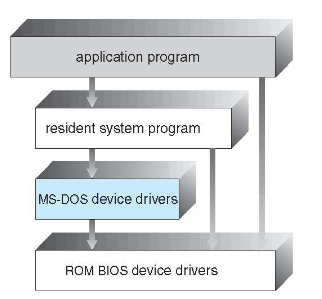
- the simplest possible
- structure not well-defined; started as a small / simple / limited system
- MS-DOS: written for maximum functionalist in minimum space
- not carefully divided into modules
- doesn't separate between user & os problem
- 👨🏫 NOT a dual system
- can cause many trouble nowadays (all user: can do sudo and all)
-
Monolithic structure: original linux
- kernel: consists of everything below the syscall interface
- and above the physical hardware
- employees multiprogramming
- 👨🏫 quite simple considering having to allocate stacks, etc.
- user: can't directly hardware
- kernel is underneath
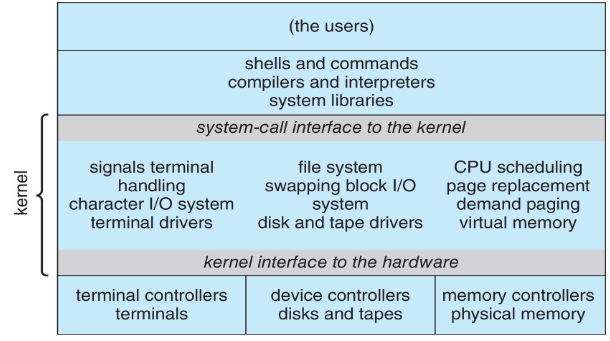
- UNIX: initially limited by hardware functionality => limited structuring
- 👨🏫 still, it is a single program!
- a single, static binary file running in a single address space
- monolithic structure!
- 👨🏫 still, it is a single program!
- UNIX: made of two separable parts
- kernel: further separated into interfaces & device drivers
- expanded as UNIX evolves
- system programs
- kernel: further separated into interfaces & device drivers
- drawback: enormous functionality: combined to one level
- difficult to implement, debug & maintain
- advantage: distinct performance!
- no need to pass parameter, etc.
- very little overhead in syscall interface and communication, etc.
- kernel: consists of everything below the syscall interface
-
Linux system structure
- i.e. modular design
- allows kernel to be modified during run time
- based on UNIT
- still, monolithic:runs entirely in kernel mode w/ single address space
- i.e. modular design
-
Modular design
- monolithic approach: too compact and tight interaction
- why not make the tie looser?
- so that change in one module / functionality does not affect the others parts!
- 👨🏫 ideally, and hopefully!
- one method: layered approach
- e.g. file system: located above hardware
-
Layered approach
- OS: divided into no. of layers
- each built on top of lower layers
- layer : hardware
- layer : user interface
- each layer: made of data structure & set of functions
- that can be invoked by higher level layers
- each layer: utilized the services from a lower layer, provides a set of functions
- and offers certain services for a higher layer
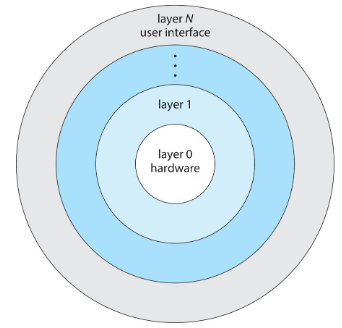
- 👨🎓 linux: all in 1 layer
- information higher: layer not needing to know lower-layer's implementation
- each layers: hides existence of its own data structures / operations to higher levels
- main advantage: simplification of construction & debugging
- layered system: successfully used in other areas too
- like TCP/IP vs. hardware (networking system)
- few systems tue pure layered approach though
- overall performance will be affected
- trend: fewer layers w/ more functionality & modularization
- while avoiding complex layer definition & interactions
- OS: divided into no. of layers
-
Mixed kernel system structure
- kernel: became large & difficult to manage
- some people: wanted to make OS a core
- and store all other nonessential parts outside
- mainstream (OS): expansion
- result: much smaller kernel
- Mach: developed at CMU in mid-1980s
- modularized the kernel w/ microkernel approach
- best-known microkernel OS: Darwin, used in Mac OS X, iOS
- consisting of 2 kernels, one being Mach microkernel
- UNIX / IBM, etc. thought it's desirable
- 👨🏫 but no general consensus on what's nonessential
- but generally: minimal process, memory management and communication facility: must be in kernel
- some of the essential functions
- provide communications between programs / services in user address space
- through message passing
- problem: if app wants to access file
- it must interact w/ file server through kernel, not directly to file / file manager
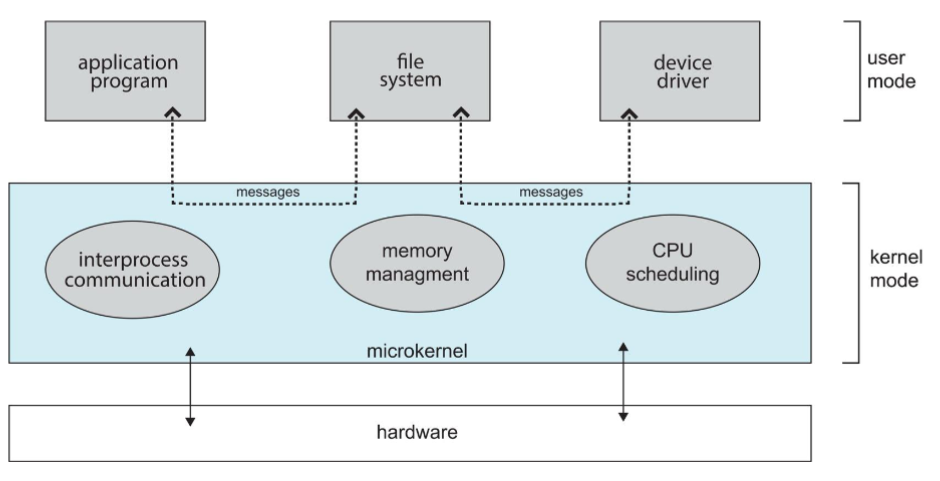
- provide communications between programs / services in user address space
- advantage
- easier to extend microkernel system (without modifying the kernel)
- minimal change to kernel
- easier to post OS to ner architectures
- more secure
- drawbacks: performance
- increased system overhead
- copying & storing messages during communication => makes it slow!
- not done by the mainstream
- Window NT: w/ layered microkernel
- much worse performance thantWindow 95 / Window XP
-
Modular approach: current methodology
- best current practice: involving loadable kernel modules (LKMs)
- i.e. programs can be added to kernel without rebooting
- once added, become a part of kernel, not user program!
- kernel: supports link to additional services
- services: can be implements & added dynamically while kernel is running
- dynamic linking: preferred to adding new features directly to kernel
- as it doesn't require recompiling kernel per every change
- resembles layer : as it has well-defined & protected interfaced
- yet, it's much more flexible
- also resembles microkernel: as primary module is only core functions and linkers
- more efficient that pure microkernel though
- linux: w/ LKMs, primarily for supporting device drivers & file systems
- LKMs: can be inserted into kernel during booting & runtime
- also can be removed during runtime!
- dynamic & modular kernel, while maintaining performance of monolithic system
- best current practice: involving loadable kernel modules (LKMs)
-
Case study: Solaris
- 👨🏫 in my days... Solaris was a dominant workstation provider
- PC wasn't a things... and we CS people used Linux
- now, the company is not computer system program though
- it worked with modular system
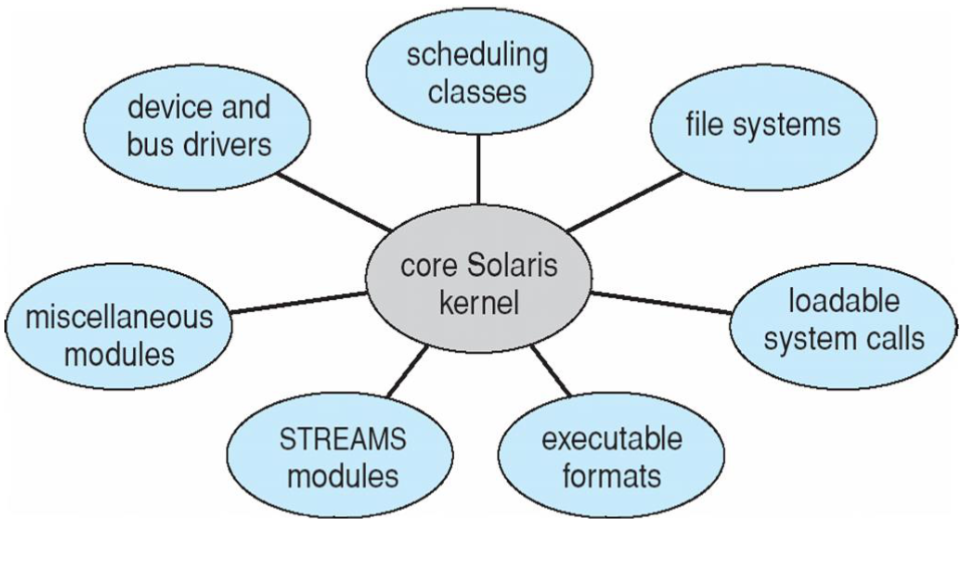
- 👨🏫 in my days... Solaris was a dominant workstation provider
-
Hybrid system
- most OS: combines benefit of different structures
- Linux: monolithic (in single address space), but also modular
- new functionality can be dynamically added
- windows: largely monolithic, with some microkernel behavior
- also provide support for dynamically loadable kernel modules
-
macOS & iOS structure
- in architecture: mcOS & iOS: have much in common
- UI, programming support, graphics, media, and even kernel environment
- Darwin: includes Mach microkernel and BSD UNIX kernel
- with dual base programs

- higher level structure
- Max OS X: hybrid, layered, Aqua UI (mouse / trackpad)
- w/ Cocoa programming environment: API for Objective-C
- core frameworks: support graphics and media
- including Quicktime & OpenGL
- kernel environment (Darwin) includes Mach microkernel & BSD
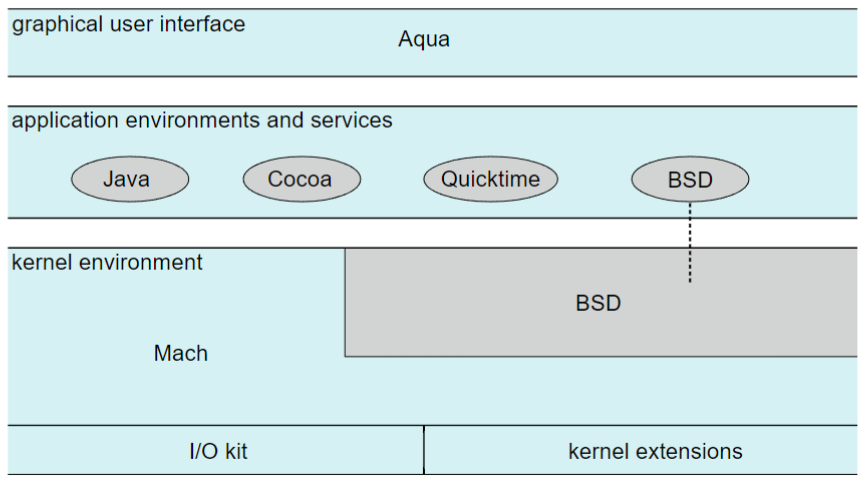
- iOS
- structured on Mac OS; added C functionality
- does not run applications natively; runs on different CPU architectures too (ARM & Intel)
- core OS: based on Mac OS X kernel, but with optimized battery
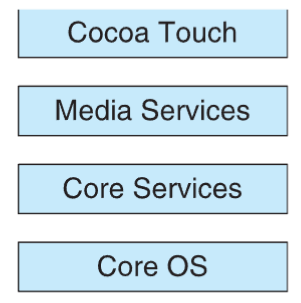
- Springboard UI: designed for touch devices
- Cocoa Touch: Object-C API for mobile app development (touch screen)
- Media services: layer for graphics, audio, video, quicktime, OpenGL
- Core services: providing cloud computing & data bases
- Core OS: based on Max OS X kernel
- Darwin
- layered system consisting of Mach microkernel & BSD UNIX kernel
- hybrid system
- two syscall interfaces: Mach syscalls (aka traps) and BSD syscalls (POSIX functionality)
- interface: rich set of libraries - standard C, networking, security, programming languages..
- Mach: providing fundamental OS services
- memory management, CPU scheduling, IPC facilities
- kernel: provide IO kit for device drivers
- dynamically loadable modules: aka kernel extensions (kexts)
- BSD: THE first implementation supporting TCP/IP, etc.
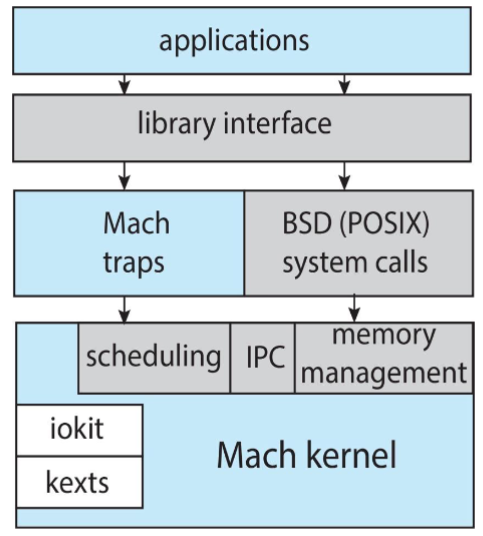
- layered system consisting of Mach microkernel & BSD UNIX kernel
- in architecture: mcOS & iOS: have much in common
-
Android
- developed by Open Handset Alliance (led by GOogle)
- runs on a variety of mobile platforms
- open-source, unlike Apple's closed-sources
- similar to OS: layered system providing rich set of frameworks
- for graphics, audio, and hardware
- using a separate Android API for Java development (not standard Java)
- Java app: execute on Android Run Time (ART)
- VM: optimized for mobile devices w/ limited memory & CPU
- Java native interface (JNI): allows developers to bypass CM
- and access: specific hardware features
- programs written in JNI: generally not portable in terms of hardware
- libraries: include framework for:
Webkit: web browser devSQLite: DB supportSSLs: network support (secure sockets)
- hardware abstract layer (HAL): abstracts all hardware
- providing applications w/ consistent view
- independent of hardware
- providing applications w/ consistent view
- uses Bionic standard C library by google, instead of GNU C library for Linux systems

Process: Introduction
-
Introduction to processes
- 👨🏫 a real thing! no more high level!
- objectives:
- identify components of process, representation, and scheduling
- describe creation & termination using appropriate syscalls
- describe and contrast inter-process communication w/ shared memory
- and message passing methods
-
Four fundamental OS concepts
- process
- instance of an executing program
- made of address space & more than 1 thread of control
- thread (continues in Ch. 4)
- single unique execution context
- full description of program stated
- captured by program counter, registers, execution flags, and stack
- for parallel operations..?
- address space (w/ address translation)
- programs: execute in address space
- != memory space of physical machine
- each program: starts w/ address 0
- programs: execute in address space
- dual mode operation (= Basic protection)
- user program / kernel: runs in different modes
- different permissions per programs
- OS & hardware: protected from user programs
- user programs: protected & isolated from one another
- process
Process concept
-
Process concept
- OS: executes a variety of programs: each runs as process
- process: captures a program execution, in a sequential manner
- von Neumann architecture
- process: contains multiple parts
- program code: aka text section
- current activities or state: program counter / processor registers
- stack: temporary data storage when invoking functions
- e.g. for function parameters, return addresses, etc.
- data section: containing global variables
- heap: w/ dynamically allocated memory during run time
- 👨🏫 stack & heap can grow dynamically: during execution
- program: passively stored on disk
- process: active entity, w/ PC specifying next instruction to fetch & execute
- process: with life cycle: from execution to termination
- program: becomes a process
- when executable file is loaded into main memory & get ready to run
- executes in address space, different from actual main memory location
- one program: can be executed by multiple processes
- a program: can be an execution environment for others (e.g. JVM)
-
Loading program into memory
- program: must be loaded to memory before execution
- load its code & static data into memory / address space
- some memory: allocated for program's runtime stack
- for C: stack used for local variables, function parameters, return addresses
- fill in: parameters for
main(): e.g.argc,argv
- OS: may allocate memory for program's heap
- programs: request & returns it explicitly
- dO: also d some initialization tasks
- esp. relating to IO
- e.g. UNIX: each process w/ 3 open file descriptors
- standard input / output / error
- esp. relating to IO
-
Memory layout of a program
- global data: divided into initialized data and uninitialized data
- separate section for
argc,argvparameters 